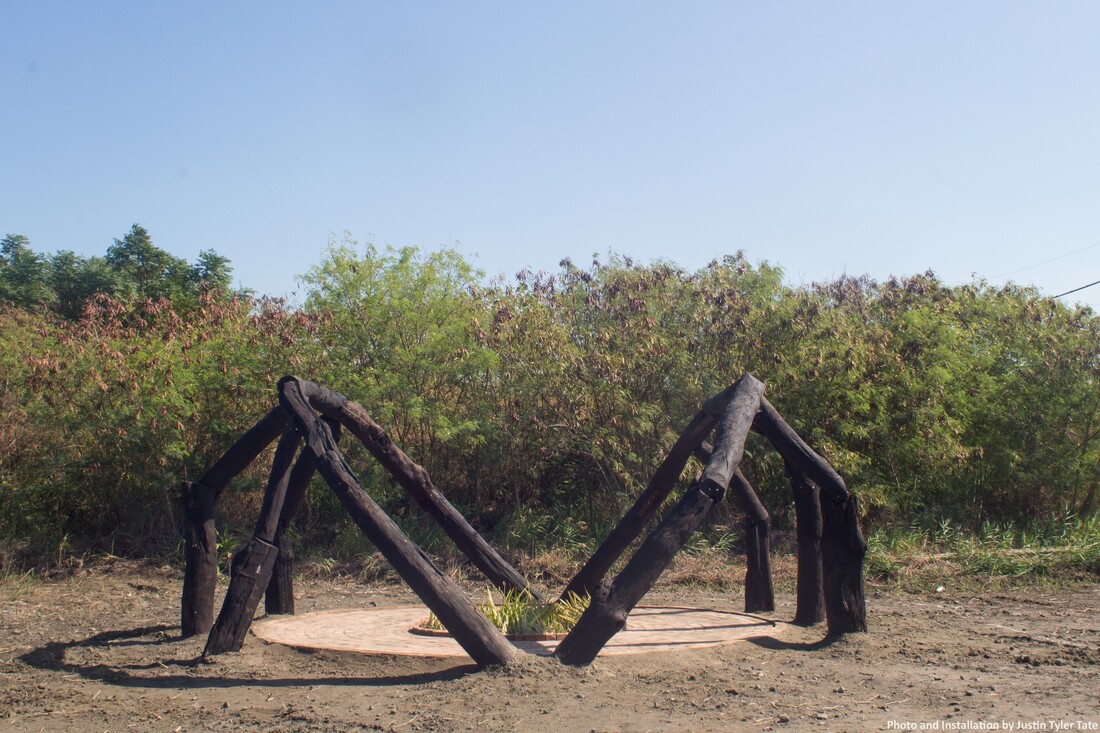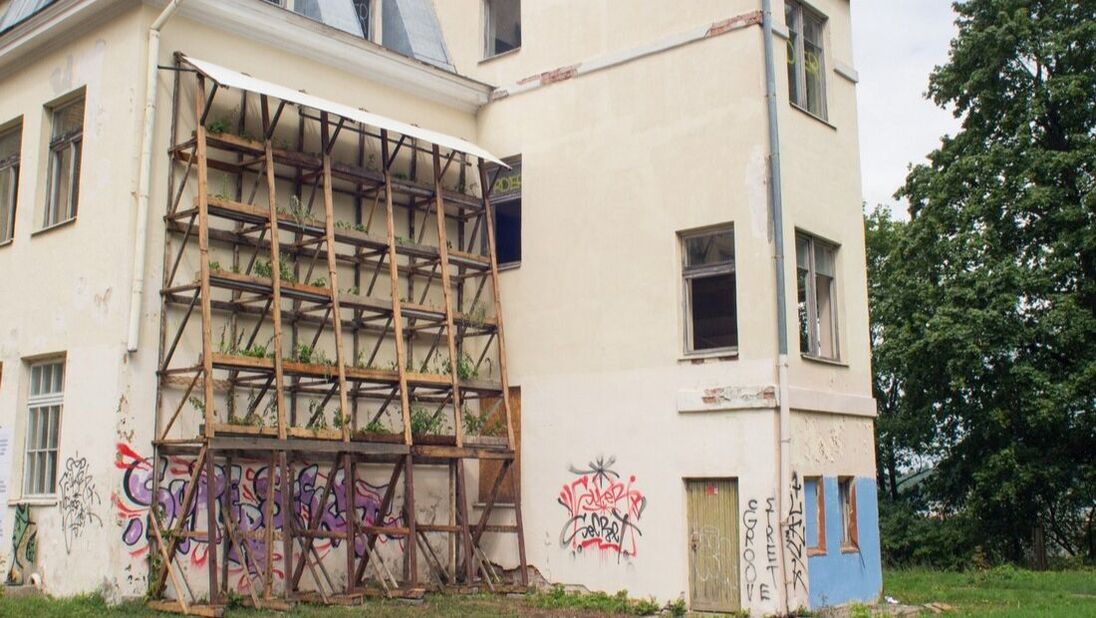Cage (籠)
5m x 4m x 2.5m
Materials: burned and treated driftwood logs, 100 lag bolts, found bricks, soil & aloe vera plants.
2021
5m x 4m x 2.5m
Materials: burned and treated driftwood logs, 100 lag bolts, found bricks, soil & aloe vera plants.
2021
|
See Cage's exact location, reviews and other photos on:
|
METHODOLOGY:
By efficiently utilizing found materials, natural techniques and minimal tools, an architectural structure is created that is both long lasting, structural and functional. Driftwood assembled into curving arches, reminiscent of a rib cage, creates an architectural form that seems to grow out of the ground. Within the area created by the driftwood, found bricks are given use, arranged, and laid using compacted earth as mortar, to create a toroidal floor-space that can be occupied by animals and/or humans for a variety of uses such as meetings, workshops, naps, exercise, resting and general congregation. Aloe plants grow in a succulent garden in the void at the center of the bricks, both enveloped and protected by the surrounding materials.
Within the work, a bubble is created whereby presently and formerly living entities work together to create a singularity that drastically contrasts the surrounding area. These disparate materials, both found and reclaimed, are rejuvenated through their utilization and manifestation as a unified entity.
By efficiently utilizing found materials, natural techniques and minimal tools, an architectural structure is created that is both long lasting, structural and functional. Driftwood assembled into curving arches, reminiscent of a rib cage, creates an architectural form that seems to grow out of the ground. Within the area created by the driftwood, found bricks are given use, arranged, and laid using compacted earth as mortar, to create a toroidal floor-space that can be occupied by animals and/or humans for a variety of uses such as meetings, workshops, naps, exercise, resting and general congregation. Aloe plants grow in a succulent garden in the void at the center of the bricks, both enveloped and protected by the surrounding materials.
Within the work, a bubble is created whereby presently and formerly living entities work together to create a singularity that drastically contrasts the surrounding area. These disparate materials, both found and reclaimed, are rejuvenated through their utilization and manifestation as a unified entity.
STORY:
The charred rib cage of a monstrous creature is all that’s left.
People say that it was as long as the town, but even with remains as big as this, it’s still hard to believe. Whether it is or it isn’t still cannot be proven, because no other pieces or parts have been found.
It’s just been there, sticking out of the ground, for as long as a memory.
We laid bricks among the ruins, so that we could walk between them, but there weren't enough bricks to be found, so the center was left empty.
Eventually a garden of aloe sprung out of the void, healing our own broken bodies as it grew.
The remains both decay and grow with time, a space that neither needs nor wants for our intervention.
As it was before, it continues to be, just with a little bit more entropy.
The charred rib cage of a monstrous creature is all that’s left.
People say that it was as long as the town, but even with remains as big as this, it’s still hard to believe. Whether it is or it isn’t still cannot be proven, because no other pieces or parts have been found.
It’s just been there, sticking out of the ground, for as long as a memory.
We laid bricks among the ruins, so that we could walk between them, but there weren't enough bricks to be found, so the center was left empty.
Eventually a garden of aloe sprung out of the void, healing our own broken bodies as it grew.
The remains both decay and grow with time, a space that neither needs nor wants for our intervention.
As it was before, it continues to be, just with a little bit more entropy.
RELATIONSHIP:
Aviale and Cage are aesthetically very different works, but they both utilize materials in the same way and, more importantly, are designed and built for ChengLong’s site-specific qualities. Aviale considers the local nature as the foundation for its design and concept, while Cage uses the local culture as its. To elaborate on what “nature” and “culture” mean in the context of ChengLong: “nature” is the importance of the surrounding wetlands, the occasional rising sea waters, and the migratory birds that stay in the area's wetlands every winter; while “culture” specifically refers to the series of sites spread across the town that create a land-based constellation of a dragon, one of them being adjacent to where the installations reside.
The works are not opposites so much as they are two sides of the same coin. They belong side by side in order to contrast each other and invite comparison. Each work uses local plants which are not just aesthetic, but have been chosen because of their ability to tolerate the local climate, in addition to their usefulness. They do not use the same materials, but both works use materials honestly, embracing their inherent qualities as critical components to the works’ designs. Because of their material considerations, Aviale has a light, airy, and almost effortless quality to how it stretches into the air, while Cage is grounded, heavy and rigid as it slowly emerges from the landscape.
Aviale and Cage are aesthetically very different works, but they both utilize materials in the same way and, more importantly, are designed and built for ChengLong’s site-specific qualities. Aviale considers the local nature as the foundation for its design and concept, while Cage uses the local culture as its. To elaborate on what “nature” and “culture” mean in the context of ChengLong: “nature” is the importance of the surrounding wetlands, the occasional rising sea waters, and the migratory birds that stay in the area's wetlands every winter; while “culture” specifically refers to the series of sites spread across the town that create a land-based constellation of a dragon, one of them being adjacent to where the installations reside.
The works are not opposites so much as they are two sides of the same coin. They belong side by side in order to contrast each other and invite comparison. Each work uses local plants which are not just aesthetic, but have been chosen because of their ability to tolerate the local climate, in addition to their usefulness. They do not use the same materials, but both works use materials honestly, embracing their inherent qualities as critical components to the works’ designs. Because of their material considerations, Aviale has a light, airy, and almost effortless quality to how it stretches into the air, while Cage is grounded, heavy and rigid as it slowly emerges from the landscape.
Cage was designed and constructed for the ChengLong Village.
The work was installed during November of 2021 in ChengLong, Yunlin, Taiwan.
The work was installed during November of 2021 in ChengLong, Yunlin, Taiwan.










